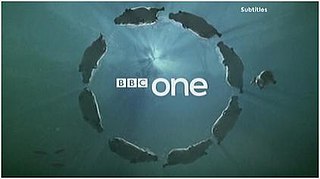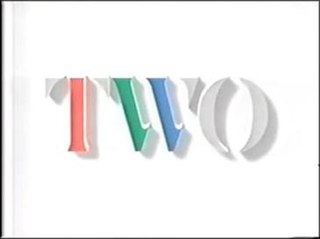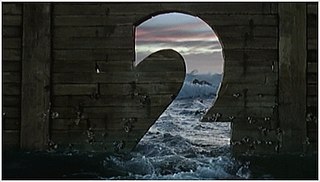
The Cube 2 was an ident used by BBC Two between 2 December 1967 and 28 December 1974. It featured a stylised "2" that rotated on screen.

The Cube 2 was an ident used by BBC Two between 2 December 1967 and 28 December 1974. It featured a stylised "2" that rotated on screen.
In 1967, BBC2 was the first UK television station to launch a full colour service on the UHF frequency band, and to mark the occasion a new symbol was launched. However, there is some confusion as to when the symbol was actually launched. Some colour programming was shown in the early part of the year, before the official date of 1 July 1967, but even the official launch date was only in the main regions. It was later that year on 2 December for the full country to receive colour transmissions, and because of these different dates, it is difficult to see when this ident was introduced. [1]

The ident was originally a cube with a "2" on each face, each a different colour. The ident would start by three light spots of red, green and blue, the three primary colours for television. These light spots then merge to form a white spot. Around this spot, a blue numeral "2" would form up by drawing it. The "COLOUR" legend would then appear below the 2, and the 2 would begin rotating to reveal other colour 2's, in the order blue, red, green and white. This ident would continue to rotate against the black background. The ident was formed by an animated startup and a film of a mechanical model, with the whole thing being played off a recording. [1] [2] [3]
The ident was modified in early 1972 when both channels presentation were brought into line. The cubed "2" was changed so all the colours were cyan blue, with the "2" now spinning above a line with an italic "COLOUR" legend. [2] [4] A variety of versions were used around this period: the first being a blue 2 over a black background with white line and caption. [3] [4] Another version included the same as before, but with a dark blue background instead of a black one. [2] [3] [4] [5] The final version included a slightly lighter background colour and a cyan line and caption. [2] [4] The black background version was first to be used, [3] which then made way for the dark blue background, with the cyan version last used, however this order is disputed. [4] These idents were mechanical, and filmed live as required from the BBC2 NODD room and lasted as long as necessary, although the ident would usually stop spinning after a while. [2] The colour was added electronically through the NODD process used on the BBC1 ident at the time. [2]
Two clocks accompanied the look: the first lasted as long as the original ident and the second accompanied the mechanical idents. The first was a modified version of the last time-piece and featured to the right of the screen, a large clock face with markers at every minute mark and with Roman numerals for every five minutes. [1] [3] To the left, the BBC2 logo, with the legend "COLOUR" underneath and below that, usually programme information. [1] [3] The second clock featured a clockface in the centre of the screen with the number markers being replaced by a set of double lines that got progressively thicker the further round the clock face. [2] [4] [5] The line, with the legend 'BBC2 COLOUR', now featuring the updated rounded BBC logo, was cyan in colour and located below the clock face. [2] [4] [5] The clock design was identical to that used by BBC1, except for colour.
Promotions at this point were not uniform and changed depending on requirements and time of year. The holding slides used for this period featured a white, "2" logo and spot located at the bottom left of the image, with a Colour legend below the 2 and programme information to the right of the 2. [1] [4] [6]
Due to lack of video recordings from this era, and due to the common broadcasting practice of wiping old tapes for reuse, very few examples survive of this era. Examples, therefore, of special idents are almost non-existent.

The BBC One Balloon idents were a series of idents used on the British TV channel BBC One from 4 October 1997 to 28 March 2002. The balloon theme replaced the computer-generated spinning globe that had been used as the main ident on the channel since 1991. It launched on the same day as a BBC-wide rebrand, and thus the new idents also carried the new BBC logo. The channel's name also changed from BBC1 to BBC One. This was the last ident set used by the channel when it fully closed down; the last proper closedown took place in the early hours of 9 November 1997. Starting the following day, BBC News 24 would broadcast on BBC One during closedown, which continues today.

Noddy was a camera system used for generating idents for the BBC One and BBC Two television channels from late 1963 to February 1985.
The history of BBC television idents begins in the early 1950s when the BBC first displayed a logo between programmes to identify its service. As new technology has become available, these devices have evolved from simple still black and white images to the sophisticated full colour short films seen today. With the arrival of digital services in the United Kingdom, and with them many more new channels, branding is perceived by broadcasters to be much more important, meaning that idents need to stand out from the competition.

The Computer Originated World (COW) was the method of creating the BBC1 symbol that was used between 18 February 1985 and 16 February 1991. It was later used by the international, commercial television service BBC World Service Television from its launch until 26 January 1995.

The BBC One "Circle" idents were a set of on-screen channel identities used on BBC One from 7 October 2006 to 4 December 2016. They also featured on the BBC Studios channel, BBC America. The idents contained images of circles being formed by nature, or people and their actions. This was the longest set of idents that was used by BBC One, as they lasted for 10 years.

The BBC Two '1991–2001' idents were broadcast from 16 February 1991 until 19 November 2001, and again from 9 July 2014 until 26 September 2018, on BBC Two in the United Kingdom. The idents, which consisted of a sans-serif '2' in Gill Sans, accompanied by the colour viridian, were created by branding agency Lambie-Nairn, who also created the Channel 4 logo.
The ITV television network in the United Kingdom began as a group of regional stations, each with their own identities. Each station used its own idents to create an individual identity.

The "Virtual Globe" was the method of creating the BBC1 symbol that was used between 16 February 1991 and 4 October 1997.

BBC Select was an overnight television service run by the BBC during the hours when BBC1 or BBC2 had closed down, usually between 2am and 6am. The channel showed programming intended for specialist audiences, such as businessmen, lawyers, nurses and teachers, and was designed to be viewed after broadcast via a video recording. It was funded by a subscription, and most programming was scrambled.
The logo of the BBC has been a brand identity for the corporation and its work since the 1950s in a variety of designs. Until the introduction of a logo in 1958, the corporation had relied on its coat of arms for official documentation and correspondence, although this crest rarely appeared onscreen. With the increased role of television for the BBC in the 1960s, particularly after the foundation of ITV, the corporation used its logo to increase viewer familiarity and to standardise its image and content. The logo has since been redesigned a number of times, most recently in 2021 with the BBC blocks, a logo designed to work across media. From 1958, there have been six different BBC logos. The first logo of the network was used from 1958 to 1963, the second from 1963 to 1971, the third from 1971 to 1992, the fourth from 1988 to 1997, the fifth from 1997 to 2021, while the sixth and current logo was adopted in October 2021.

The BBC TwoPersonality idents were a set of idents used on BBC Two from 19 November 2001 until 18 February 2007. The idents were produced by the Lambie-Nairn branding agency, who had created the previous look. The idents feature an ivory sans serif white '2' in a yellow environment and performing a variety of tasks, and a purple boxed BBC Two logo.

The BBC Two "Two" ident was the station identification used on BBC2 between 30 March 1986 and 16 February 1991. It was the last non-corporate look for the channel, and the only look until 2018 that did not feature a numeral '2' in the design.
BBC Schools, also known as BBC for Schools and Colleges or BBC Education, is the educational programming strand set up by the BBC in 1957, broadcasting a range of educational programmes for children aged 5–16. From launch until June 1983, programming was based on BBC1 during the daytime, apart from coverage of major news events which saw the programmes shifted to BBC2. In September 1983, programming was transferred permanently to BBC2 freeing BBC1 to develop its own daytime schedule. The strand, named Daytime on Two, remained on BBC Two until March 2010, later supplemented by the 'Class TV' strand on CBBC.
BBC One used a number of different idents from the time of the station launch on 2 November 1936 until the station took on the Mirror Globe Idents on 15 November 1969.

The Window on the World idents were a set of idents used by BBC Two from 18 February 2007 until 13 November 2014. They were created by Abbott Mead Vickers BBDO and produced by Red Bee Media. The idents featured a number 2 cut out of, or made out of parts of the everyday environment.

The Computer Generated 2 was an ident used by BBC2 between 16 June 1979 and 30 March 1986. It was the first computer generated television station identification in the world.
The Striped 2 was an ident used by BBC2 between 28 December 1974 and 16 June 1979. The ident featured a numeral 2 made out of horizontal lines.

The launch ident was a television station identification used by BBC Two between their launch night in 1964 and the introduction of colour in 1967.
Throughout the years, Children's BBC, and later CBBC and CBeebies, have used a number of different identities. The branding of the stranded service is distinctive both in the past and at present.
The presentation and the identities of the BBC News channel in the UK alongside its international counterpart and the BBC Parliament coverage channel use specific identities that demonstrate their remit and purpose.